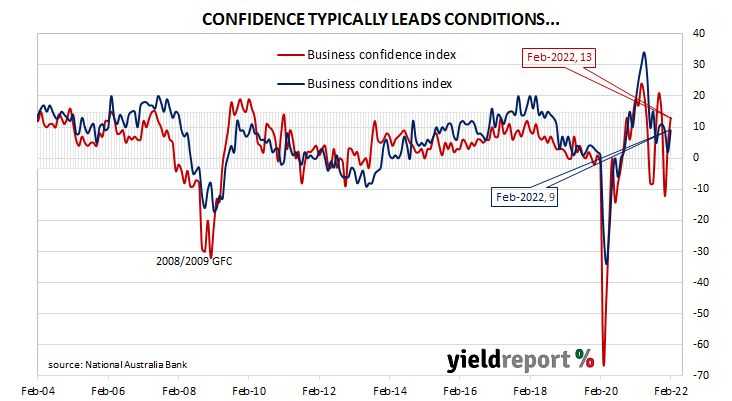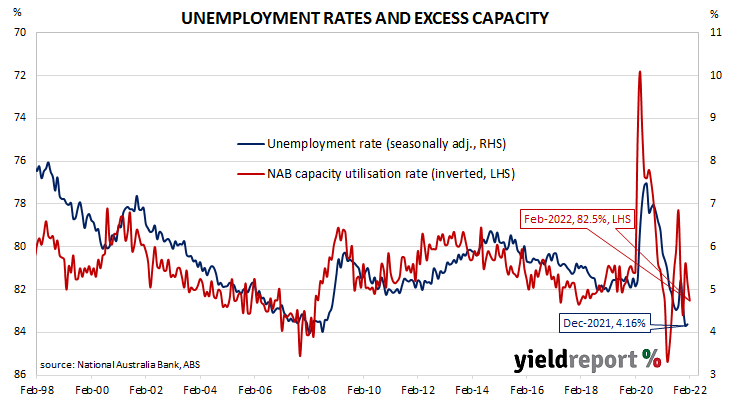Summary: Business conditions improves in February; confidence improved markedly again; fewer health-related employment disruptions, strong labour demand; trading, profitability improves; “lot of room for improvement”, conditions, capacity utilisation below Delta reopening period; capacity utilisation rate up, 6 of 8 sectors of economy at/above respective long-run averages; retail price inflation “elevated”, cost pressures increasingly passed on to consumers.
NAB’s business survey indicated Australian business conditions were robust in the first half of 2018, with a cyclical-peak reached in April of that year. Readings from NAB’s index then began to slip, declining to below-average levels by the end of 2018. Forecasts of a slowdown in the domestic economy began to emerge in the first half of 2019 and the index trended lower, hitting a nadir in April 2020 as pandemic restrictions were introduced. Conditions improved markedly over the next twelve months, only to revert back to more normal levels in the latter part of 2021.
According to NAB’s latest monthly business survey of over 400 firms conducted over the last week of February, business conditions have improved. NAB’s conditions index registered 9, up from January’s reading of 2.
“The rebound came on the back of a strong rise in the employment index, reflecting fewer health-related employment disruptions and strong labour demand, as well as improvements in trading and profitability,” said NAB senior economist Brody Viney.
Business confidence improved markedly for a second consecutive month. NAB’s confidence index rose from January’s revised reading of 4 to 13, back above the long-term average. Typically, NAB’s confidence index leads the conditions index by approximately one month, although some divergences have appeared in the past from time to time.
Commonwealth Government bond yields increased noticeably on the day. By the close of business, the 3-year ACGB yield had gained 9bps to 1.68%, the 10-year yield had added 10bps to 2.24% while the 20-year yield finished 8bps higher at 2.78%.
In the cash futures market, expectations of a change in the actual cash rate, currently at 0.05%, firmed in favour of rate rises in the second half of 2022. At the end of the day, contract prices implied the cash rate would creep up from the current rate of 0.050% to 0.125% by May, then increase to 0.575% by August and then to 1.46% by February 2023.
“The improvement was broad-based across most key indicators, industries and states. But there is still a lot of room for improvement. Conditions and capacity utilisation remained just below the Delta reopening period and well below the pre-Delta lockdown period,” said ANZ senior economist Catherine Birch.
NAB’s measure of national capacity utilisation continued to recover from December’s drop and it rose from January’s revised figure of 81.7% to 82.5%. Six of the eight sectors of the economy were reported to be operating at or above their respective long-run averages. The retail and mining sectors were the exceptions.
Capacity utilisation is generally accepted as an indicator of future investment expenditure and it also has a strong inverse relationship with the unemployment rate.
NAB’s Viney noted retail price inflation remained “elevated” and “cost pressures are increasingly being passed on to consumers.” However, he said the pressure on prices “continue to be driven more by temporary purchase cost factors rather than more sustained wage and labour cost pressures.”



